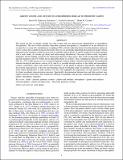Abiotic ozone and oxygen in atmospheres similar to prebiotic earth
Abstract
The search for life on planets outside our solar system will use spectroscopic identification of atmospheric biosignatures. The most robust remotely detectable potential biosignature is considered to be the detection of oxygen (O2) or ozone (O3) simultaneous to methane (CH4) at levels indicating fluxes from the planetary surface in excess of those that could be produced abiotically. Here we use an altitude-dependent photochemical model with the enhanced lower boundary conditions necessary to carefully explore abiotic O2 and O3 production on lifeless planets with a wide variety of volcanic gas fluxes and stellar energy distributions. On some of these worlds, we predict limited O2 and O3 buildup, caused by fast chemical production of these gases. This results in detectable abiotic O3 and CH4 features in the UV-visible, but no detectable abiotic O2 features. Thus, simultaneous detection of O3 and CH4 by a UV-visible mission is not a strong biosignature without proper contextual information. Discrimination between biological and abiotic sources of O2 and O3 is possible through analysis of the stellar and atmospheric context—particularly redox state and O atom inventory—of the planet in question. Specifically, understanding the spectral characteristics of the star and obtaining a broad wavelength range for planetary spectra should allow more robust identification of false positives for life. This highlights the importance of wide spectral coverage for future exoplanet characterization missions. Specifically, discrimination between true and false positives may require spectral observations that extend into infrared wavelengths and provide contextual information on the planet's atmospheric chemistry.
Citation
Domagal-Goldman , S D , Segura , A , Claire , M W , Robinson , T D & Meadows , V S 2014 , ' Abiotic ozone and oxygen in atmospheres similar to prebiotic earth ' , Astrophysical Journal , vol. 792 , no. 2 , 90 . https://doi.org/10.1088/0004-637X/792/2/90
Publication
Astrophysical Journal
Status
Peer reviewed
ISSN
0004-637XType
Journal article
Collections
Items in the St Andrews Research Repository are protected by copyright, with all rights reserved, unless otherwise indicated.

